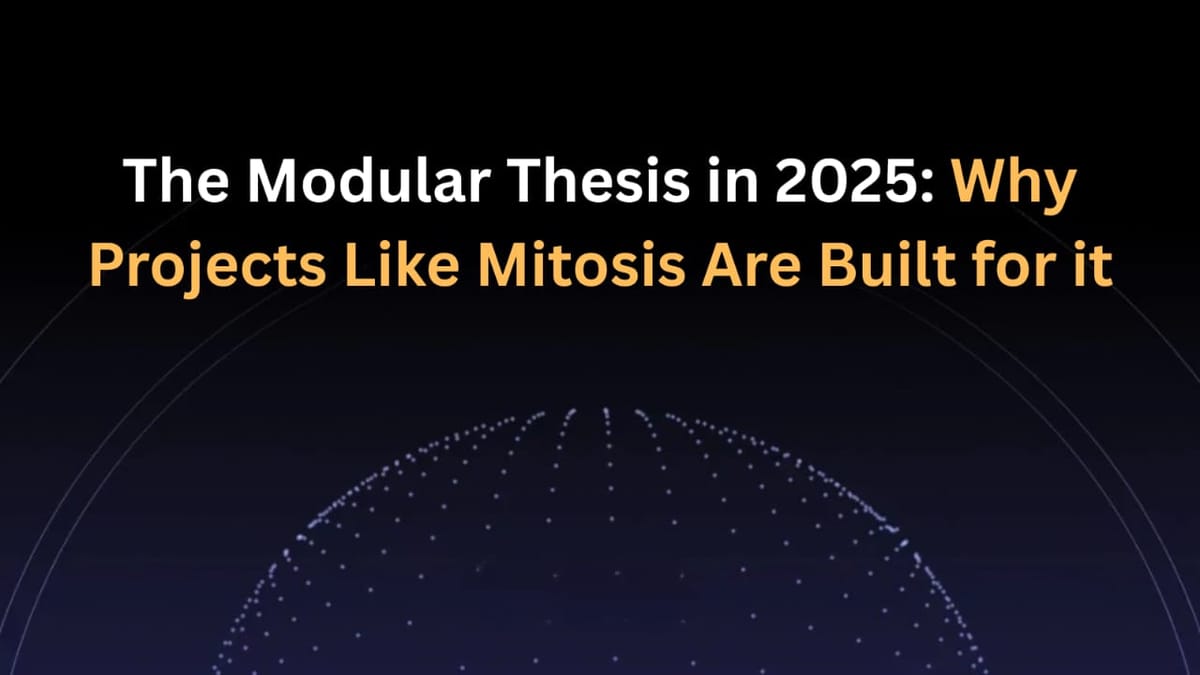The Modular Thesis in 2025: Why Projects Like Mitosis Are Built for It

Introduction
In 2025, the modular blockchain thesis has moved from theory to reality.
Instead of building monolithic chains that do everything consensus, execution, settlement, and data availability, new protocols are embracing specialization.
Projects like Celestia, AltLayer, Dymension, and Rollkit lead this modular revolution.
But with new architectures come new challenges, especially around liquidity fragmentation across different modular layers and rollups.
This is where Mitosis enters the conversation, a liquidity coordination layer purpose-built for the modular world.
In this article, we'll explore how modular chains work in 2025, why liquidity is a critical problem, and why Mitosis’ native design is positioned to solve it.
1. What Modular Means in 2025
Modular blockchain architecture refers to the separation of concerns across different layers of the blockchain stack:
- Data Availability (DA): Ensuring transaction data is publicly available and verifiable (e.g., Celestia).
- Execution: Running application-specific logic (e.g., Rollups on Celestia, AltLayer instances).
- Settlement: Finalizing and securing state transitions (sometimes still done on Ethereum or other Layer 1s).
- Consensus: Agreeing on the correct ordering of transactions.
In a modular setup:
- Rollups focus only on execution.
- DA layers like Celestia or EigenDA provide scalable data services.
- Settlement layers can vary based on the app's security and trust requirements.
This separation enables faster innovation, better scalability, and application-specific optimization.
However, it also splits liquidity across many independent chains and rollups, creating a new set of interoperability problems.
2. The Liquidity Challenge in a Modular World
In a modular environment, you don't have one chain, you have hundreds of rollups, rollapps, and sovereign execution layers.
Key problems arise:
- Liquidity Fragmentation:
Assets are siloed inside specific rollups or appchains, leading to inefficient markets and user friction. - Bridge Complexity:
Moving assets between two modular chains often requires bridges, adding latency, fees, and security risks. - User Experience:
Users must constantly bridge, wrap, and unwrap tokens when interacting across multiple modular chains.
If every modular chain needs its own liquidity bootstrapping, the UX deteriorates fast.
The modular future demands a seamless liquidity layer, something natively fast, trust-minimized, and chain-agnostic.
3. Mitosis: Native Fit for Modular DeFi
Mitosis is designed to be modular-native, with architecture that solves the liquidity fragmentation issue without relying on wrapped assets or external bridges.
Key features:
- Shared Liquidity Pools Across Chains:
Mitosis uses a system of common liquidity pools that exist simultaneously across multiple chains.
Liquidity providers contribute once, and Mitosis syncs that liquidity across different modular environments. - No Wrapped Assets:
Mitosis doesn't "bridge and wrap" tokens like traditional bridges (e.g., Axelar, Wormhole).
Instead, it coordinates native assets across rollups. - Fast and Native Withdrawals:
Thanks to optimistic state syncing (with light proofs), users get fast exit capabilities without relying on third-party validators. - Permissionless Chain Onboarding:
Any modular chain can plug into Mitosis if it meets basic requirements.
No need for centralized governance to whitelist chains.
This design makes Mitosis a perfect liquidity layer for modular ecosystems where hundreds of rollups and rollapps will constantly spin up and down.
4. 2025 Modular Projects That Could Integrate Mitosis
Celestia Rollups:
Many rollups settling on Celestia will need external liquidity access to avoid isolated, illiquid markets.
Mitosis’ chain-agnostic model could allow these rollups to tap into shared pools easily.
Dymension RollApps:
Dymension enables fast deployment of custom rollapps.
Each rollapp has its own token, and without a liquidity solution like Mitosis, token trading across rollapps becomes fragmented and costly.
AltLayer Instances:
AltLayer provides "rollups-as-a-service."
Deployed rollups will want immediate access to deep liquidity without bootstrapping from scratch exactly what Mitosis pools can offer.
Other Possibilities:
- Rollkit chains (modular SDKs for building execution layers).
- Polygon CDK chains (sovereign chains using modular DA and execution).
- Sovereign OP Stack rollups.
All of these modular deployments share one need: efficient, secure, composable liquidity movement, the niche Mitosis is positioned to dominate.
(External references:
- Celestia Documentation
- Dymension RollApps Overview
- AltLayer Official Site)
Conclusion: Mitosis Is Built for the Modular Future
The modular blockchain thesis changes the game.
Instead of a few monolithic chains, we’ll have thousands of specialized, sovereign rollups and appchains by 2025.
Without a native liquidity coordination layer, modular innovation risks collapsing under liquidity fragmentation and poor UX.
Mitosis is not just compatible with this future, it is built for it.
By offering shared liquidity pools, fast native exits, and permissionless onboarding, Mitosis becomes a critical primitive for the next wave of modular DeFi.
As Celestia, Dymension, and other modular ecosystems grow, expect Mitosis to become the "invisible layer" that powers liquidity behind the scenes — making modular chains feel as seamless and liquid as today’s top monolithic chains.



Comments ()